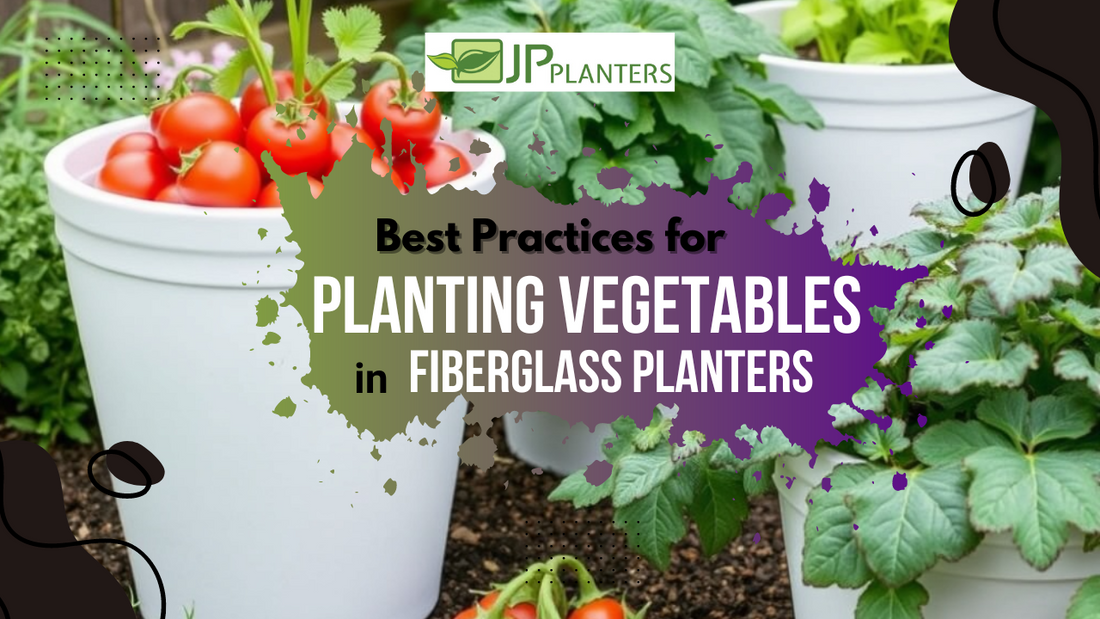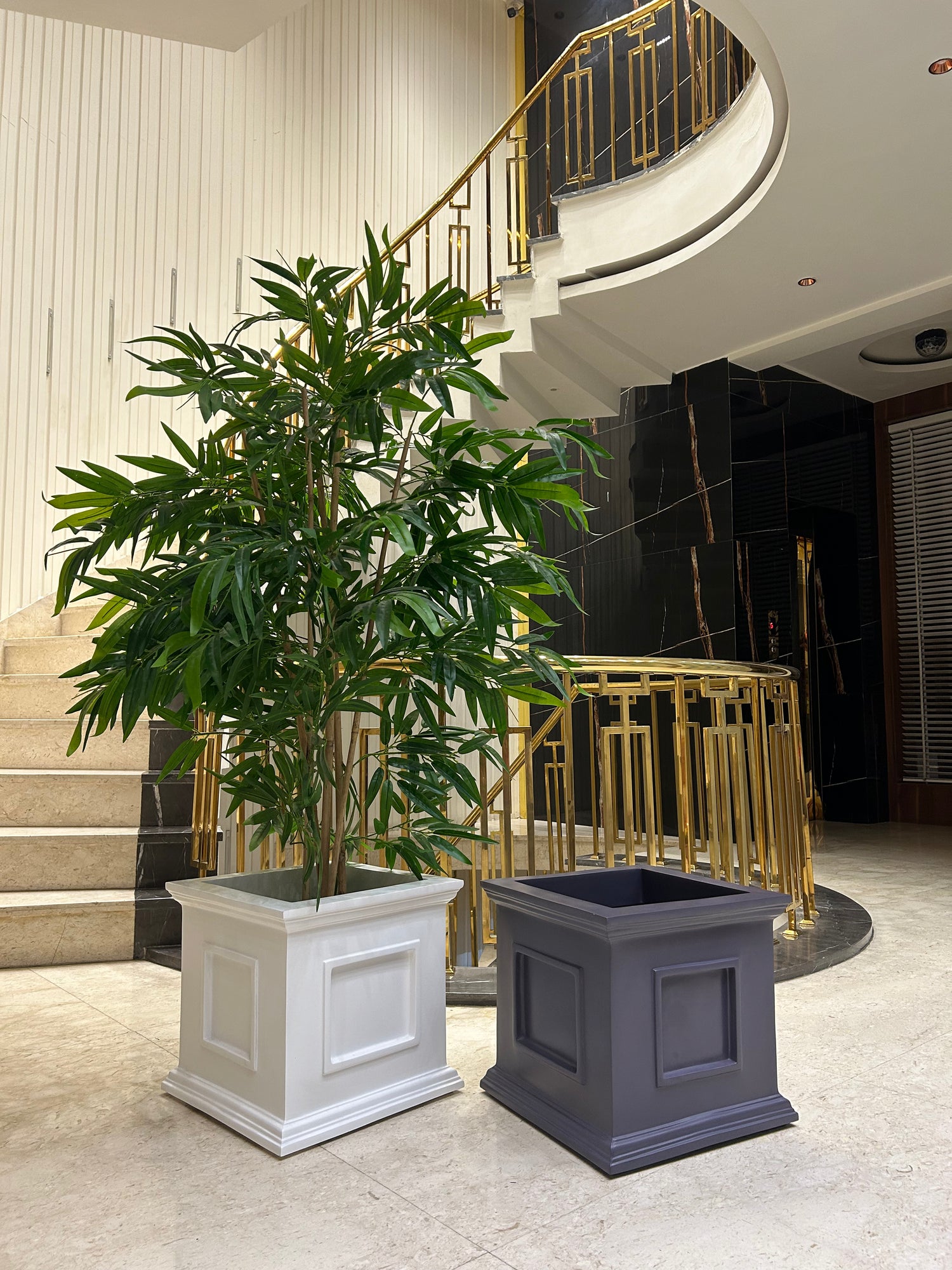
Best Practices for Planting Vegetables in Fiberglass Planters
Share
Gardening in small spaces has seen a surge in popularity in recent years, with more urban dwellers and home gardeners discovering the joy of growing their own vegetables. As this trend continues, fiberglass planters (also known as FRP Planters) are becoming a top choice for those looking to create a thriving vegetable garden on their balcony, patio, or any compact outdoor space. In a world where pollution is at its peak, there is a lot of mixing of chemicals in food, vegetables etc that can easily affect our body. We need to learn about planting vegetables in our home too. So that these fresh veggies will keep ourselves healthy & strong.
And in the modern world there is a lot of importance of planters too because they are our plants home. So we are talking about one of the most trending planters ie., Fiberglass Planters. mThese planters offer a stylish, durable, and versatile solution that enhances both the aesthetics and functionality of your garden. In this comprehensive guide, we will explore the best practices for planting vegetables in fiberglass planters, from preparation to seasonal planting tips, and provide expert recommendations to ensure your vegetable garden flourishes all year round.
Benefits of Fiberglass Planters for Vegetable Gardening
Fiberglass planters offer numerous benefits that make them ideal for vegetable gardening, particularly in smaller outdoor spaces:
- Lightweight and Durable: Fiberglass planters are much lighter than traditional clay or ceramic pots, making them easy to move around and reposition as needed. Despite their lightweight nature, they are incredibly durable and can withstand the wear and tear of outdoor environments, including wind, rain, and UV exposure. Even your small kids can carry these planters. They are that much light weighted.
- Weather Resistant: These planters are resistant to all types of weather conditions, from intense sun to heavy rain. Unlike wooden planters, they do not rot or corrode over time, and their non-porous surface helps retain moisture in the soil, creating an optimal environment for vegetable growth. Even plastic planters break over the period of time due to different weather seasons, but these FRP Planters won’t.
- Versatility in Design: Available in a range of sizes, shapes, and finishes, fiberglass planters are perfect for any space, whether you have a large garden or a small balcony. This versatility makes them ideal outdoor planters that can complement both decorative and functional uses.
Step-by-Step Guide for Planting Vegetables in Fiberglass Planters
Step 1: Selecting the Right Planter
Choosing the right size and shape of your fiberglass planter is crucial for the health and growth of your vegetables. Consider the following factors:
- Size Matters: Larger vegetables, like tomatoes or zucchinis, require deeper and wider planters to accommodate their root systems. Opt for planters that are at least 12-18 inches deep. For smaller vegetables or herbs, such as lettuce or parsley, a shallower planter will suffice.
- Planters for Balcony: If you're working with limited space, consider tall, narrow planters that fit well on balconies or patios. They maximize vertical space and allow for efficient use of the available area.
Explore Our Collection: Browse our range of fiberglass planters, perfect for vegetables, from compact models ideal for balcony gardens to larger planters designed for patios or garden areas.
Step 2: Preparing the Planter
Proper preparation of your planter is key to a successful vegetable garden:
- Add Drainage Holes: Ensure your fiberglass planter has adequate drainage. If not, drill small holes at the bottom to prevent water from pooling, which can lead to root rot.
- Soil Mix: Use a high-quality potting mix with good drainage properties. Combine equal parts compost, perlite, and peat moss for a nutrient-rich, well-draining soil that promotes healthy plant growth.
Step 3: Planting Process
Follow these steps to plant your vegetables correctly:
- Spacing and Depth: Plant your vegetables according to their specific spacing and depth requirements. For instance, tomatoes should be planted deep, with only the top leaves visible, while lettuce requires shallow planting.
- Arrangement: Consider companion planting to maximize space and create a balanced ecosystem. For example, plant basil alongside tomatoes to naturally deter pests.
Step 4: Watering and Maintenance
Proper watering is crucial for the health of your vegetable garden:
- Watering Frequency: Water your plants thoroughly but allow the soil to dry slightly between waterings. Overwatering can lead to root rot, while underwatering can cause wilting and reduced yields.
- Soil Moisture Levels: Regularly check the soil moisture by inserting your finger about 1 inch into the soil. If it feels dry, it’s time to water. Invest in a moisture meter for more accurate readings.
Step 5: Seasonal Planting Tips
Different vegetables thrive in different seasons, so planning accordingly is key:
- Spring and Summer: Vegetables like tomatoes, peppers, cucumbers, and beans are best planted in spring or early summer. Fiberglass planters retain warmth, making them ideal for these warmer months.
- Fall and Winter: Consider planting cool-season vegetables like spinach, kale, or carrots in the fall. The insulation properties of fiberglass help protect plants from early frosts, allowing for extended growing seasons.
Recommended Vegetables for Fiberglass Planters
Not all vegetables are equally suited for container gardening. Here are some of the best "plants for outdoor" settings that thrive in fiberglass planters:
- Tomatoes: Require deep, wide planters for proper root growth.
- Leafy Greens: Lettuce, spinach, and kale grow well in shallow containers.
- Herbs: Basil, parsley, and cilantro are ideal for smaller, compact planters.
- Root Vegetables: Carrots and radishes do well in tall planters with adequate depth.
Range of Planters that will surely enhance Indoor & Outdoor Space
Our collection of fiberglass, aluminum, and corten steel planters offers a variety of options to enhance the look of your garden or balcony. Each type has its unique benefits:
- Fiberglass Planters: Lightweight, weather-resistant, and available in various designs and sizes. Perfect for both small spaces and larger garden areas.
- Aluminum Planters: Modern and sleek, aluminum planters provide a contemporary look while being highly resistant to rust and corrosion.
- Corten Steel Planters: Add a rustic charm to your garden with corten steel planters, known for their unique weathered appearance and exceptional durability.
Shop Now: Visit our online store to explore our full range of planters and pots. Find the perfect match for your gardening needs today!
Maintenance Tips for Fiberglass Planters
To extend the life of your fiberglass planters, follow these maintenance tips:
- Cleaning: Clean your planters periodically with mild soap and water to remove dirt and prevent mold or algae growth.
- Protect from Extreme Weather: Although fiberglass is weather-resistant, it’s best to store planters indoors during harsh winters to prevent any potential damage.
Conclusion
Planting vegetables in fiberglass planters is an excellent way to enjoy fresh, homegrown produce, regardless of your available space. With their lightweight, durable, and weather-resistant properties, FRP planters are a perfect choice for creating a thriving vegetable garden on your balcony, patio, or garden area. Ready to start your own vegetable garden? Browse our extensive range of online planters and pots to find the perfect option for your space and needs.
With these tips and insights, you're all set to make the most of your space and enjoy the rewards of growing your own vegetables. Happy gardening! 🌱


